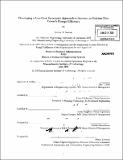| dc.contributor.advisor | Leon Glicksman and Sarah Slaughter. | en_US |
| dc.contributor.author | Stewart, Jeremy M. (Jeremy Matthew) | en_US |
| dc.contributor.other | Leaders for Global Operations Program. | en_US |
| dc.date.accessioned | 2010-10-12T18:02:46Z | |
| dc.date.available | 2010-10-12T18:02:46Z | |
| dc.date.copyright | 2010 | en_US |
| dc.date.issued | 2010 | en_US |
| dc.identifier.uri | http://hdl.handle.net/1721.1/59178 | |
| dc.description | Thesis (M.B.A.)--Massachusetts Institute of Technology, Sloan School of Management; and, (S.M.)--Massachusetts Institute of Technology, Engineering Systems Division; in conjunction with the Leaders for Global Operations Program at MIT, 2010. | en_US |
| dc.description | Cataloged from PDF version of thesis. | en_US |
| dc.description | Includes bibliographical references (p. 87-91). | en_US |
| dc.description.abstract | Data centers consume approximately 1.5% of total US electricity and 0.8% of the total world electricity, and this percentage will increase with the integration of technology into daily lives. In typical data centers, valued added IT equipment such as memory, servers, and networking account for less than one half of the electricity consumed, while support equipment consumes the remaining electricity. The purpose of this thesis is to present the results of developing, testing, and implementing a low-cost, systematic approach for increasing the energy efficiency of data centers. The pilot process was developed using industry best practices, and was piloted at a Raytheon site in Garland, TX. Because the approach is low-cost, there is an emphasis on increasing the energy efficiency of data centers' heat removal and lighting equipment. The result of implementing the low-cost systematic approach, consisting of both technical and behavior modifications, was a 23% reduction in electricity consumption, leading to annual savings of over $53,000. The improvement to the heat removal equipment's energy efficiency was 54%. In addition to presenting the results of the pilot, recommendations for replicating the pilot's success are provided. Two major managerial techniques are described - creating an aligned incentive structure in both Facilities and IT departments during the data center design phase, and empowering employees to make improvements during the use phase. Finally, a recommended roll out plan, which included a structure for Data Center Energy Efficiency Rapid Results Teams, is provided. | en_US |
| dc.description.statementofresponsibility | by Jeremy M. Stewart. | en_US |
| dc.format.extent | [iv], 99 p. | en_US |
| dc.language.iso | eng | en_US |
| dc.publisher | Massachusetts Institute of Technology | en_US |
| dc.rights | M.I.T. theses are protected by
copyright. They may be viewed from this source for any purpose, but
reproduction or distribution in any format is prohibited without written
permission. See provided URL for inquiries about permission. | en_US |
| dc.rights.uri | http://dspace.mit.edu/handle/1721.1/7582 | en_US |
| dc.subject | Sloan School of Management. | en_US |
| dc.subject | Engineering Systems Division. | en_US |
| dc.subject | Leaders for Global Operations Program. | en_US |
| dc.title | Developing a low-cost, systematic approach to increase an existing data center's Energy Efficiency | en_US |
| dc.type | Thesis | en_US |
| dc.description.degree | S.M. | en_US |
| dc.description.degree | M.B.A. | en_US |
| dc.contributor.department | Leaders for Global Operations Program at MIT | en_US |
| dc.contributor.department | Massachusetts Institute of Technology. Engineering Systems Division | |
| dc.contributor.department | Sloan School of Management | |
| dc.identifier.oclc | 659783651 | en_US |
